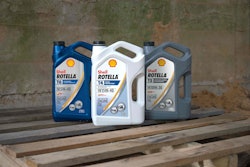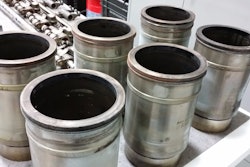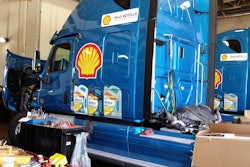 Shell this week gave members of the press a look at parts from an engine teardown from a Detroit DD15 engine that used a low-viscosity grade Shell Rotella oil in its last roughly 400,000 miles. Shell said there was no difference in the wear on the engine’s parts between this engine and ones in similar teardowns from engines that used conventional viscosity grades. Catch more on the teardown on CCJ next week.
Shell this week gave members of the press a look at parts from an engine teardown from a Detroit DD15 engine that used a low-viscosity grade Shell Rotella oil in its last roughly 400,000 miles. Shell said there was no difference in the wear on the engine’s parts between this engine and ones in similar teardowns from engines that used conventional viscosity grades. Catch more on the teardown on CCJ next week.For about 20 years now, consistently tightening emissions regulations have spurred not only major changes to engine design and hardware, they’ve also been one of the key drivers, if only indirectly, to changes in lubricants technology, says Shell OEM Technical Manager Dan Arcy.
As engines have changed, so too has the oil needed to keep them protected properly, Arcy says.
Also complicating the engine oil equation in recent years, says Shell’s new Technology Manager Jason Brown, is the expectation — and, of course, the need — for engines to do more with less.
“We’re asking more from engines,” Brown said. “We’re asking engines to be more powerful, pull more, be stronger, do more — and we’re asking them to do it with less energy,” he said, referring to both industry and regulatory demands that engines be more fuel efficient.
Where Shell steps into the equation, especially for upcoming regulations on fuel consumption and related greenhouse gas emissions, is with its lower-viscosity oil, set to hit the market late next year or early 2017.
Proposed Category 11 heavy-duty engine oil, the certification tests for which are still being developed and finalized, include two new types of oil: One with the viscosity grade, or thickness, of the current CJ-4 engine oils, and one with a lower-viscosity grade — effectively, thinner oil.
PC-11B, as the thinner version is named for now, will allow engine components to move with less resistance, thus increasing efficiency and fuel economy.
If low-viscosity oils can increase fuel economy by just 1 percent — a figure Shell is confident that will be met and possibly even exceeded — the world will use about 1 million fewer gallons of diesel a day, a collective savings of more than $1 billion a year for diesel buyers and users like fleets.
The challenge with low-viscosity PC-11B oils, however, is ensuring they protect engines as well as thicker, conventional oils.
But, as I wrote last year from another PC-11 update from Shell, the company’s ready to shut the door on those concerns. “We’ve completed 22 million miles of testing with PC-11B type oils,” Arcy said. “And the durability is going to be there.”
More from Shell’s annual global media event, held this week in San Antonio, will be posted this week.











